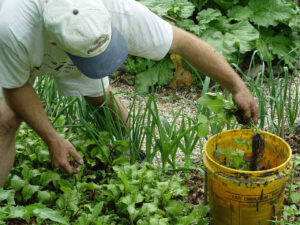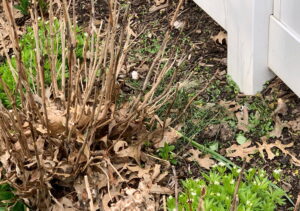Composting in Place
June 6th, 2023
Weeds rank high on most gardeners’ list of landscape vexations, but that’s one problem that’s never bothered me too much.

George on weed patrol with five-gallon bucket at his side.
For one thing, my strategy of planting real plants wall-to-wall and mulching the limited or temporary openings doesn’t leave much room for weeds to get started.
Plus, I’ve never minded going on regular weed patrols with my trowel and five-gallon bucket. I look at it as “harvesting compost.” Adding those young yanked weeds to the compost bin turns the enemy into an asset – plus it gives me an excuse to enjoy up-close-and-personal looks at the developing shrubs, flowers, and vegetables.
The key is getting on top of the weed issue and staying on top. It’s so much easier to do regular but light cleanups than to try and corral an outbreak after it’s gone out of control.
I know about that first-hand, too, after taking over a landscape that was completely ignored for 10 years.
See before and after photos of George’s landscape makeover
Now is an important waypoint in the weed journey since June is a peak month both for the germination of summer weeds and the maturation of weeds that sprouted in spring. Allowing any of those weeds to go to seed will magnify your future troubles.
It may seem overwhelming now as those weeds keep coming and coming. But the good news is that if you do a thorough cleanup now, the germination rate goes down from here on out.
Some people turn to weed-killers for help. That’s a viable option if you’re careful how and where you spray and follow the label instructions.
Not everyone has the back acumen and energy to get down there and pull, so herbicides become the only viable alternative to hiring out the weed-control work. (Landscapers usually lean to herbicides anyway and generally charge top dollar even if they’re willing to go the pull/dig route.)
Kill-everything herbicides also can make sense as a one-time solution to bring a total mess back under control, essentially leveling the playing field for a fresh start.
I’ve occasionally used spot-sprays but mostly avoid herbicides for a few reasons.
One is that I’d rather garden with as limited risk to beneficial organisms, myself, and the environment in general as possible.
Another is that I don’t like the look of the browned-out weeds left behind, which can take weeks to break down… unless I remove them after they’re dead (which is counter-productive if the point is to save work).
And a third reason is that I like the idea of using the nutrients and organic matter in weeds as a compost ingredient. (I avoid composting toxic weeds like poison ivy or the few weeds that have gone to seed before I could yank them.)
As I’m aging, I’m always on the lookout for ways to minimize work, especially the bend-over kind.
One technique I’ve been using more and more is the idea of “composting in place,” or in other words, hiding pulled weeds under nearby plants instead of lugging them by the bucket full to the compost bin.
I’m apparently not the only aging gardener embracing the idea.
I just read a new book called “Compost Science for Gardeners” (New Society Publishers, $22.99 paperback, 2023) in which the author, Canadian Master Gardener Robert Pavlis, talks about what he calls the “cut-and-drop” method of weeding.
Pavlis, who also owns and cares for the six-acre Aspen Grove Gardens in Guelph, Ontario, says this composting in place is a useful labor-saver for weeds as well as end-of-season perennials, deadheaded flowers, and other garden trimmings.

Pulled weeds have been tossed in a small pile behind the hydrangea, which is about to leaf out.
“Wherever you are in the garden, leave the plant waste where you stand,” Pavlis writes. “Nature has been composting organic matter that sits on the surface of the soil for thousands of years. Why not let her take care of the composting for you?”
An example is leaving hosta leaves to decay in place at the end of winter instead of raking them.
“The old hosta flower stems might still be vertical, so I take some hedge trimmers and
cut them off, about six inches at a time,” says Pavlis. “The cuttings are left where they fall. Any other dead foliage is treated in a similar way. Just cut it and drop it.”
This time of year, Pavlis uses cut-and-drop for deadheaded flowers and for pruned stems and foliage.
“If the plant is near the front of the bed, I fling the cut piece behind a larger plant at the back to keep things looking neat,” he says.
In fall, Pavlis leaves the leaves where they drop, too, “provided it is in a flower or shrub bed. On the grass, I either mow them into small bits and leave them or rake them into a nearby flower bed that needs some extra organic matter.”
Even most weeds (except for ones that have produced mature seeds) can be dropped instead of hauled to the compost bin, Pavlis says.
“If I have concerns about rooting, I leave them on the garden path for a couple of days to dry out in the sun, and then I throw them into the flower bed,” he says.
Weed exceptions to cut-and-drop are ones Pavlis calls “just too nasty,” such as bindweed, quack grass, and Canada thistle.
“They either go out with the garbage, or they are dropped on the lawn to die,” he says.
As for lawn grass that creeps into flower beds, “I pull it out and toss it onto the lawn,” Pavlis says. “It either dies or roots. Either is OK with me.”







